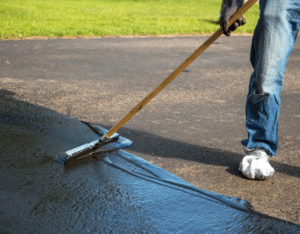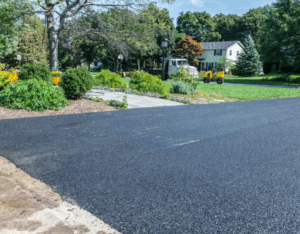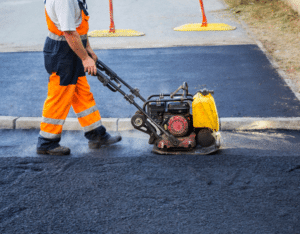Introduction
Asphalt maintenance plays a vital role in ensuring the longevity and functionality of our infrastructure. Regular inspections are essential to identify and address any issues before they escalate into major problems. This proactive approach not only saves costs but also improves overall safety on our roads and pavements.
By conducting regular asphalt maintenance inspections, property owners and authorities can detect early signs of deterioration, such as cracks, potholes, or uneven surfaces. Addressing these issues promptly prevents further damage and extends the lifespan of the asphalt surfaces. It also minimizes the need for costly repairs or complete replacement in the future. Moreover, maintaining well-preserved asphalt surfaces improves safety for pedestrians, cyclists, and motorists. Regular inspections allow for the identification and repair of potential hazards, such as loose gravel, damaged curbs, or drainage problems. This ensures a smooth and secure surface, reducing the risk of accidents and injuries.
Regular asphalt maintenance inspections are crucial for preserving and enhancing our asphalt investments effectively. They not only save costs in the long run but also significantly contribute to improving safety on our roads and pavements. By addressing minor issues promptly, we can ensure the durability and functionality of our infrastructure for years to come.

Understanding Asphalt Maintenance Inspections
An asphalt maintenance inspection refers to the systematic evaluation of asphalt pavements to identify any signs of wear or damage and address them promptly. The main objective of these inspections is to ensure the long-term durability, functionality, and safety of the asphalt surfaces. By conducting regular inspections, any potential issues can be detected early on, allowing for timely and cost-effective repairs or maintenance activities. The frequency of asphalt maintenance inspections depends on various factors, including traffic volume, climate conditions, and the age of the pavement. Generally, it is recommended to conduct inspections at least once a year. However, in areas with heavy traffic or extreme weather conditions, more frequent inspections may be necessary. New pavements or recently repaired sections should also be inspected more frequently during the initial years to monitor their performance.
Regular inspections enable property owners, facility managers, or maintenance personnel to identify and address minor problems like cracks, potholes, or drainage issues before they escalate into major structural damage. Timely repairs can prevent further deterioration, extend the lifespan of the pavement, and minimize the need for expensive reconstruction or rehabilitation projects. Furthermore, asphalt maintenance inspections contribute to overall safety by identifying potential hazards and preventing accidents, such as tripping or slipping incidents caused by deteriorated pavement surfaces. By understanding the importance of these inspections and following the recommended frequency, individuals can effectively preserve and enhance their asphalt investments.
Key Benefits of Regular Inspections
Regular inspections of asphalt pavement offer several key benefits that are critical for preserving and enhancing the investment. One of the primary advantages is the ability to prevent major repairs. By conducting inspections on a regular basis, potential issues can be identified early on, allowing for prompt repairs and preventing the need for costly and extensive repairs in the future. Not only does this save money, but it also helps to extend the overall lifespan of the asphalt pavement.
Another significant benefit of regular inspections is the improvement in safety. Poor road conditions can lead to accidents and injuries. By identifying and addressing any existing or potential safety hazards, such as potholes, cracks, or uneven surfaces, regular maintenance inspections help ensure that the road is safe for drivers, cyclists, and pedestrians. Additionally, regular inspections contribute to the aesthetic maintenance of the property. The condition of the pavement can greatly impact the overall appearance and appeal of the property. Well-maintained asphalt not only enhances the property’s visual appeal but also positively influences the impression of visitors and potential buyers. This, in turn, can affect property value and contribute to a positive image for businesses.
Regular maintenance inspections for asphalt pavement offer key benefits that include preventing major repairs, improving safety, and maintaining aesthetic appeal. By investing in regular inspections and timely repairs, individuals and businesses can effectively preserve and enhance their asphalt investments.
What to Look For During Asphalt Inspections
During asphalt inspections, there are several key factors to consider in order to effectively maintain and preserve the integrity of the asphalt surface.
First, it is important to identify and address cracks in the asphalt. Different types of cracks, such as alligator, longitudinal, and transverse cracks, can indicate different issues with the asphalt. Alligator cracks, for example, resemble a pattern resembling the skin of an alligator and can indicate structural failure. Longitudinal cracks run parallel to the pavement’s centerline, while transverse cracks are perpendicular to the pavement’s centerline. The size, type, and location of the cracks will determine the appropriate solution, which can range from crack sealing to resurfacing or complete reconstruction. Potholes are another common issue that should be inspected during asphalt maintenance. Potholes can form from water infiltration, freeze-thaw cycles, or general wear and tear of the asphalt surface. These depressions not only pose a threat to vehicles and pedestrians but can also cause further damage to the pavement if left unattended. The best practices for repairing potholes involve cleaning out debris, filling the hole with a suitable material, and compacting it properly to ensure a durable and smooth surface. Proper water drainage is crucial for the longevity of asphalt. Insufficient drainage can lead to ponding or pooling of water, which can weaken the underlying layers and cause cracks and potholes. Signs of inadequate drainage include the presence of standing water or water channeling across the pavement. In such cases, addressing the drainage issues by installing or repairing drains, slopes, or gutters is essential. Surface oxidation is another issue to look out for during inspections. Asphalt surfaces can undergo oxidation due to exposure to sunlight and environmental factors. Signs of oxidation include color fading, brittleness, or a rough texture. Applying a seal coat can help protect the asphalt from further oxidation and restore its appearance and durability. Lastly, it is crucial to inspect the edges of asphalt areas for any breaks or crumbling. These edge breaks can indicate structural failures and should be repaired promptly. Ignoring edge breaks can lead to further deterioration and more extensive repair in the future.
Regular asphalt maintenance inspections with a focus on these checkpoints will help preserve and enhance the lifespan of asphalt investments, ensuring the safety and functionality of the surface.
Tools and Techniques for Effective Inspections
Regular asphalt maintenance inspections play a vital role in preserving and enhancing asphalt investments. By identifying potential issues early on, property owners can prevent small concerns from escalating into costly repairs. Here are some key tools and techniques that can greatly enhance the effectiveness of these inspections:
1. Visual Inspections: Visual inspections are a fundamental part of any maintenance program. During these inspections, it is crucial to look for signs of cracking, potholes, depressions, or uneven surfaces. These findings should be documented in detail, including photographs and measurements if possible. This documentation will help track deterioration over time and provide a basis for future maintenance decisions.
2. Use of Technology: Technology has revolutionized asphalt inspections, providing more accurate and efficient means of assessment. Drones equipped with cameras allow inspectors to survey large areas quickly, capturing detailed images from different angles. Infrared cameras can detect subsurface issues by capturing temperature variations. Ground-penetrating radar can provide a non-destructive exploration of the asphalt layers, revealing any hidden structural defects.
3. Professional Assessments: While visual inspections and technology tools are valuable, some situations may require the expertise of a professional inspector or engineering consultant. Complex issues such as deep-rooted structural problems or extensive pavement distress may necessitate specialized equipment and expertise. Professional assessments can provide in-depth analysis and recommendations for repairs or rehabilitation.
Conducting regular asphalt maintenance inspections using a combination of visual inspections, technology tools, and professional assessments is key to preserving and enhancing asphalt investments. By staying proactive, property owners can ensure the longevity and functionality of their asphalt surfaces.
Common Pitfalls in Asphalt Maintenance
Regular asphalt maintenance inspections are crucial in maintaining the longevity and integrity of any paved surface. Unfortunately, many individuals tend to neglect these inspections, often resulting in long-term consequences for their asphalt investments.
One common pitfall in asphalt maintenance is the neglect of regular inspections. Failing to conduct routine assessments of the asphalt’s condition can lead to small issues going unnoticed and eventually escalating into major problems. For instance, cracks and potholes left unchecked can worsen over time, leading to costly repairs or even the need for complete resurfacing. Another common pitfall is the reliance on do-it-yourself (DIY) approaches for addressing asphalt maintenance issues. While DIY fixes may seem cost-effective and convenient, they often fail to address underlying issues effectively. DIY repairs, such as filling cracks with inexpensive sealants, may provide temporary relief but do not address the root causes of the deterioration. In the long run, these unprofessional fixes can lead to recurring problems and further damage to the asphalt surface.
Regular asphalt maintenance inspections ensure that potential issues are identified and addressed promptly before they worsen. By hiring professional asphalt maintenance experts, property owners can access specialized knowledge, advanced techniques, and high-quality materials required to effectively preserve and enhance their asphalt investments. Neglecting these inspections or relying solely on DIY fixes can have significant and costly consequences, making regular inspections an essential aspect of asphalt maintenance.

Conclusion
Asphalt maintenance inspections are of utmost importance in preserving and enhancing your asphalt investments. By conducting these inspections on a timely basis, you can identify and address potential issues before they escalate into costly repairs. Proactive maintenance is a cost-effective strategy compared to reactive repairs, as it helps in extending the lifespan of your asphalt surfaces and reducing long-term expenses.
Throughout the maintenance inspection process, there are key issues to monitor. These include but are not limited to cracks, potholes, drainage problems, and surface fading or deterioration. By closely monitoring these issues, you can address them promptly through preventative measures such as crack sealing, sealcoating, and proper water drainage systems. Regular inspections also allow for the early detection of any underlying structural damage caused by heavy traffic, extreme weather conditions, or other external factors. By identifying and addressing such issues in a timely manner, you can prevent further deterioration and ensure the safety and functionality of your asphalt surfaces for an extended period.
In summary, regular asphalt maintenance inspections are crucial for preserving and enhancing your asphalt investments. By staying proactive and addressing issues early on, you can save significant costs in the long run while maximizing the lifespan and performance of your asphalt surfaces.



